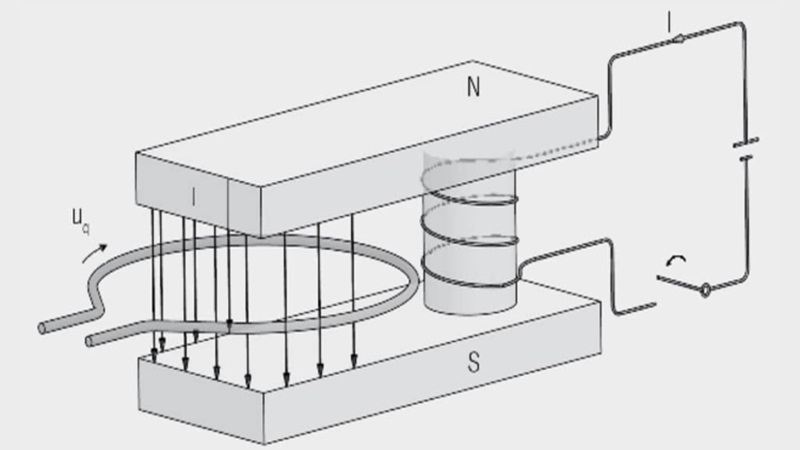This article provides a detailed overview of fundamental magnetic principles, focusing on magnetic induction, magnetic flux, and Faraday’s Law. It explores key concepts such as the generation of electromotive force in conductors due to changes in magnetic flux and the application of these phenomena in magnetic components and inductors. Additionally, it examines the practical implications of these principles in the design and operation of electrical and electronic devices.

Magnetic induction B
A potential is induced in a conductor loop if the magnetic field passing through the conductor loop changes with time.
The surge in potential over the loop area is known as the magnetic induction B. Like the magnetic field strength, the magnetic induction B is a vector quantity.
The following relationship applies for the magnetic induction B:
The magnetic induction (B) is the quotient of the induced potential surge:
![potential induced magnetic surge [2]](https://www.doeeet.com/content/wp-content/uploads/2024/10/potential-induced-magnetic-surge-2.webp)
![magnetic induction equation [1]](https://www.doeeet.com/content/wp-content/uploads/2024/10/magnetic-induction-equation-1.webp)
magnetic induction equation [1]
and the product of the winding turns (N) and the windings area (A) of the induction coil.
The unit of magnetic induction (B) is the Tesla (T) = Vs/m2.
The magnetic induction B and the field strength H are proportional to one another. The constant of proportionality is the magnetic field constant (μ0), given by experimental measurement.
![magnetic field constant [3]](https://www.doeeet.com/content/wp-content/uploads/2024/10/magnetic-field-constant-3.webp)
magnetic field constant [3]
In vacuum and also with sufficient accuracy for air, this leads to:
![magnetic induction equation [4]](https://www.doeeet.com/content/wp-content/uploads/2024/10/magnetic-induction-equation-4.webp)
magnetic induction equation [4]
The magnetic induction (BL) in air for the above example is then given by:
![magnetic induction in air environment [5]](https://www.doeeet.com/content/wp-content/uploads/2024/10/magnetic-induction-in-air-environment-5.webp)
magnetic induction in air environment [5]
Magnetic Flux F
The magnetic flux (F) is the scalar product of the magnetic flux density (B) and the area vector (dA).
![magnetic flux equation [6]](https://www.doeeet.com/content/wp-content/uploads/2024/10/magnetic-flux-equation-6.webp)
magnetic flux equation [6]
If (B) passes perpendicular through the area and the field is homogeneous:
![magnetic flux equation in homogeneous field [7]](https://www.doeeet.com/content/wp-content/uploads/2024/10/magnetic-flux-equation-in-homogeneous-field-7-1.webp)
magnetic flux equation in homogeneous field [7]
The unit of magnetic flux (F) is the same as that of the voltage surge (Vs) (Voltsecond) or Weber (Wb).
Faraday’s law
Up until now we have considered static magnetic fields. If the magnetic flux changes with time, a voltage U is induced (Faraday’s law).
![induced voltage Faradys Law [8]](https://www.doeeet.com/content/wp-content/uploads/2024/10/induced-voltage-Faradys-Law-8.webp)
induced voltage Faradys Law [8]
- U = induced voltage
- t = time
The polarity of the voltage is such that a current is generated on closing a circuit whose induced magnetic field opposes the original magnetic flux, i.e. it tends to reduce the magnetic field (Lenz’s rule – Figure 1.).

Figure 1. Representation of Lenz’s rule. The imposed magnetic field induces a current in the direction such that its induced magnetic field opposes the imposed field
Taking a winding with N turns, Faraday’s law can be expressed in the following form.
![Faraday law with N turns winding [9]](https://www.doeeet.com/content/wp-content/uploads/2024/10/Faraday-law-with-N-turns-winding-9.webp)
Faraday law with N turns winding [9]
A = cross section of the coil
l = length of the coil or of the magnetic circuit
I = current through the coil
L = inductance of the coil [H(enry) = Vs/A]
So the inductance limits the change in current once a voltage is applied. It can be calculated from the coil data:
![coil inductance equation [10]](https://www.doeeet.com/content/wp-content/uploads/2024/10/coil-inductance-equation-10.webp)
coil inductance equation [10]
AL = AL value; mostly in nH/N2
The energy stored in the magnetic field is subject to the following relationships:
![energy stored in magnetic field equation [11]](https://www.doeeet.com/content/wp-content/uploads/2024/10/energy-stored-in-magnetic-field-equation-11.webp)
energy stored in magnetic field equation [11]
The energy stored in the volume V is composed of both the magnetic field strength H and the magnet flux density B. For transformers and chokes with ferromagnetic cores, the flux density is limited by saturation and is constant throughout the magnetic circuit. If an air gap is introduced (material with permeability μ~1), the field strength is highest in this air gap with H = B/μ. It follows that the energy density is highest in the air gap. One also speaks of the energy being stored in the air gap.
